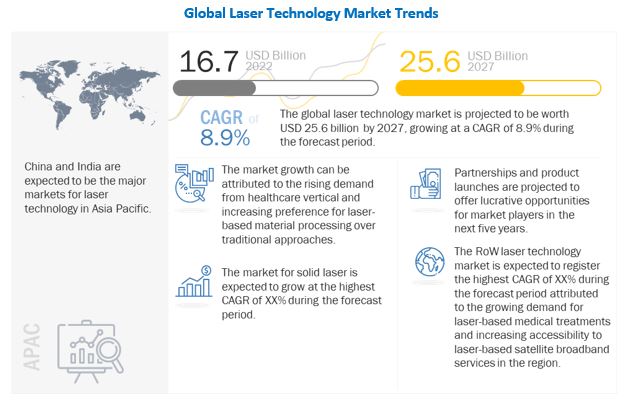
The laser technology market is estimated to be US$16.7 billion in 2022 and is projected to reach US$25.6 billion by 2027, at a CAGR of 8.9%, increasing investments in R&D for developing laser-based weapons, increasing adoption of laser technology in optical communication, and growing preference of laser-based techniques for material processing across verticals such as automotive, semiconductor & electronics, and industrial are major factors driving the growth of the laser technology market, reports MarketsandMarkets. Additionally, growing adoption of smart manufacturing techniques is another key driver for the market.
Solid laser to grow at the highest growth rate during the forecast period
Solid lasers and solid laser-based systems find applications across various verticals such as medical where they are used for spectroscopy and microscopy applications and automotive where they are used for metal processing applications. They are also used in optical transmission systems in the telecommunications industry and find applications in the defense industry owing to their ability to meet extreme power requirements.
System segment held the largest share and laser segment to register the highest growth during the forecast period
Laser engraving systems are extensively used for the marking of aircraft parts in the aerospace vertical. Additionally, laser engraving and marking systems are also used for development of smart cards and unique identification cards. The applications of lasers in the combat vehicles industry are increasing; lasers are mounted atop combat vehicles to track and detect enemy drones and support anti-drone capabilities. In the coming years, laser and laser systems are expected to provide support troops with additional security against artillery, rockets, drones, mortars, and cruise missiles.
Optical communication to demonstrate highest growth during the forecast period
Laser technology's low-payload weight feature makes it suitable for space telescopes, onboard satellites, and scientific space probe applications. In the coming years, laser technology is expected to gain importance in space applications, especially for transmitting large quantities of data between satellites. With increasing bandwidth requirements and a shift to 100G transceivers, the demand for lasers in optical communication is also growing. Laser technology devices play a vital role in broadband communications systems, which are used as high-speed transmitters in analog and digital fiber networks.
Medical vertical to register the highest growth during the forecast period
Laser technology are being extensively used in the medical vertical. The applications of laser technology in the medical sector include flow cytometry, cell sorting, microscopy, DNA sequencing, retinal scanning, plastic joining, metal welding, liquid processing, precision cleaning, stent cutting, cardiac pacemaker, and catheter laser welding systems. Optically pumped semiconductor lasers (OPSL) and diode lasers, resulting in a continuous solid UV laser enable the use of UV in clinical and research environments. Similarly, during the process of joining plastics in medical applications, a sealing system is required. Lasers offer reliable sealing in a single step, thereby increasing the adoption of laser technology in the medical domain. Lasers are also used extensively in therapeutics.














